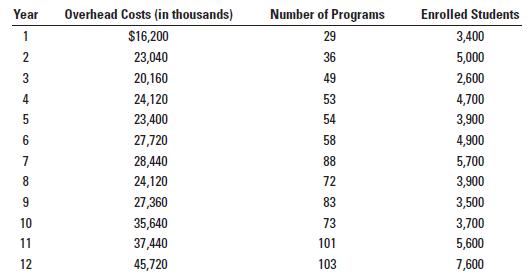Evaluating multiple regression models, not-for-profit. Instructions Form groups of two or more students to complete the following
Question:
Evaluating multiple regression models, not-for-profit.
Instructions
Form groups of two or more students to complete the following requirements:
Required
1. Given your findings in Problem 10-32, should Hanks use multiple regression analysis to better understand the cost drivers of overhead costs? Explain your answer.
2. Hanks decides that the simple regression analysis in Problem 10-32 should be extended to a multiple regression analysis. She finds the following result:
■ Regression 3. Overhead costs = a + (b 1 × number of academic programs) + (b 2 × number of enrolled students)

The coefficient of correlation between number of academic programs and number of students is 0.60. Evaluate the multiple regression model. (Assume linearity, and constant variance and normality of residuals.) Should Hanks choose the multiple regression model over the two simple regression models of Problem 10 32?
3. How might the president of Eastern University use these regression results to manage overhead costs? How might the University use the regression results such as the Durbin Watson statistic to manage overhead costs?
Data From Problem 10-32:
Kathy Hanks, executive assistant to the president of Eastern University, is concerned about the overhead costs at her university. Cost pressures are severe, so controlling and reducing overhead is very important. Hanks believes overhead costs incurred are generally a function of the number of different academic programs (including different specializations, degrees, and majors) that the university has and the number of enrolled students. Both have grown significantly over the years. She collects the following data:

■ Regression 1. Overhead costs = a + (b × number of academic programs)

■ Regression 2. Overhead costs = a + (b × number of enrolled students)

Step by Step Answer:

Cost Accounting A Managerial Emphasis
ISBN: 978-0133138443
7th Canadian Edition
Authors: Srikant M. Datar, Madhav V. Rajan, Charles T. Horngren, Louis Beaubien, Chris Graham





